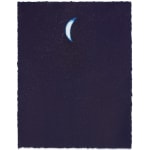-
Artworks
Miya Ando b. 1973
008 Kudarizuki (Waning Crescent), 2023Natural Indigo, Micronized Pure Silver, Hahnemühle Paper11 x 8.5 in
27.94 x 21.59 cm8891Further images
This work is part of Miya Ando’s series of indigo paintings of the moon. The title describes in Japanese and English the phase the moon was in on the night...This work is part of Miya Ando’s series of indigo paintings of the moon. The title describes in Japanese and English the phase the moon was in on the night that Ando painted it. Ando began painting the moon in indigo on the first day of COVID lockdown in New York City. She painted the moon every day, exactly as it was, for two and a half years. She called the project Moon Almanac. She ended that project on September 7, 2022, the day the Mayor of New York declared it was okay to stop wearing masks in public. She chose indigo and silver on cotton paper as her medium for various reasons: indigo and cotton are materials found in nature, and this series is essentially a documentation of the processes of the natural world; silver is also a natural element, and is a color frequently used to describe the appearance of the moon and stars; also, like the phases of the moon, natural indigo dye is essentially a time-keeping mechanism since the longer indigo stays in contact with a paper surface, the darker blue that surface becomes. Although the COVID phase of her Moon Almanac project has come to an end, Ando has continued creating indigo paintings of the moon in its various phases and manifestations. The titles of all of Ando’s moon phase paintings are presented in two languages. Ando is half Japanese and half American, and is bi-lingual. She has made an exhaustive study of words and phrases that exist in Japanese that do not seem to have an English equivalent. She refers to these linguistic anomalies as “lacunae” or lexical gaps. She has cataloged more than 1100 Japanese words and phrases describing specific manifestations of the moon that do not have straightforward English equivalents. Ando is currently pursuing a series titled “Future Moons,” for which she picks dates in the future and paints the phase the moon is projected to be in on that date. As part of this series, she has begun looking into the languages of the Indigenous cultures of the Western Hemisphere, which similarly to Japanese culture are attuned to the natural world and whose languages reflect a minute observation of nature. This project compares nature-based cultures via language, illustrated by the significant vocabularies describing the moon and its manifestations. That research has revealed that indeed many Western Indigenous languages accommodate scores, sometimes even hundreds more ways of describing the moon and its manifestations than are offered by the English language. Ando has received permission from certain tribal authorities to utilize some of these words and phrases to describe the paintings in her “Future Moon” series. The title of each of these paintings reflects the language from which it originates.







